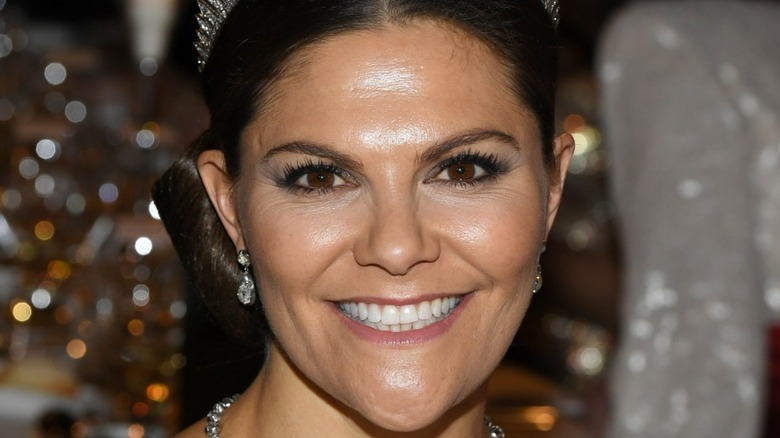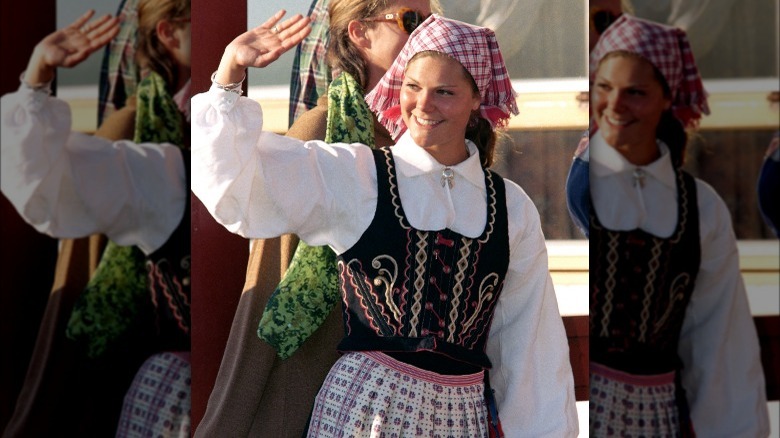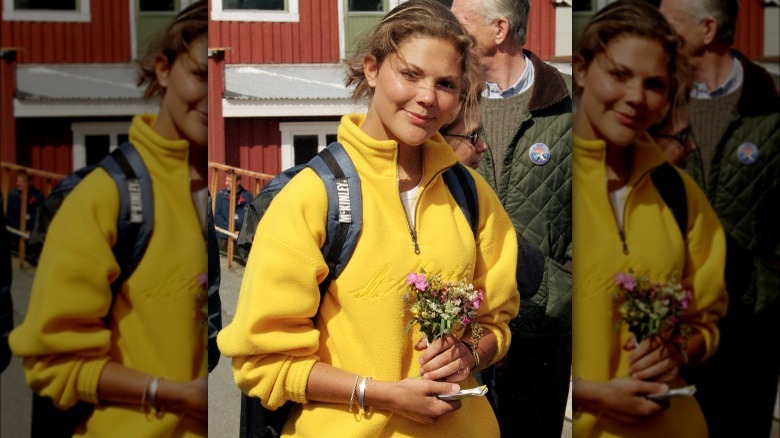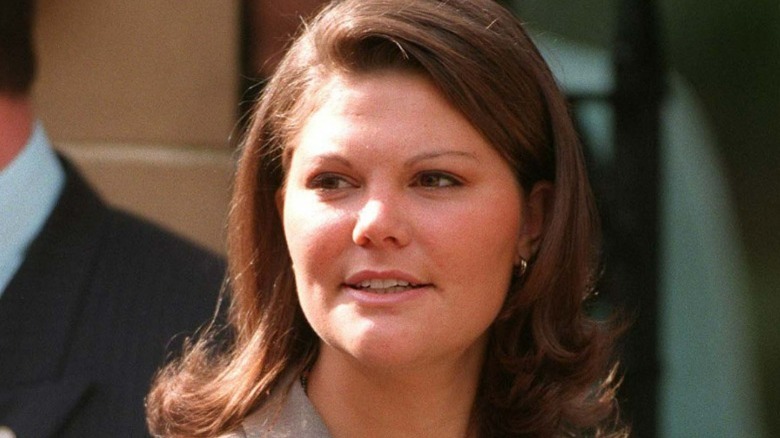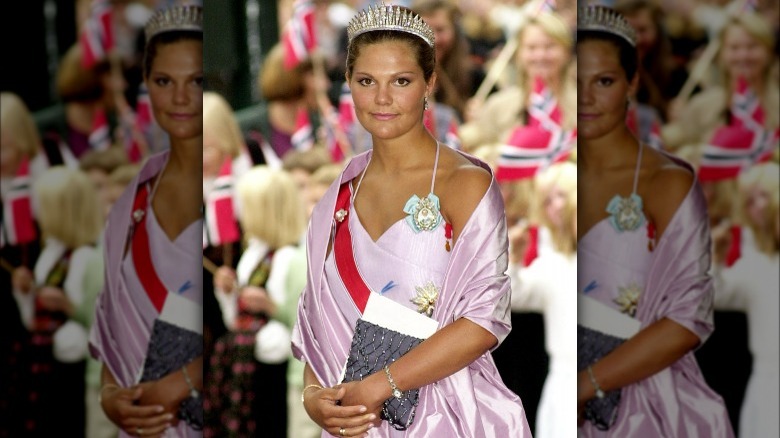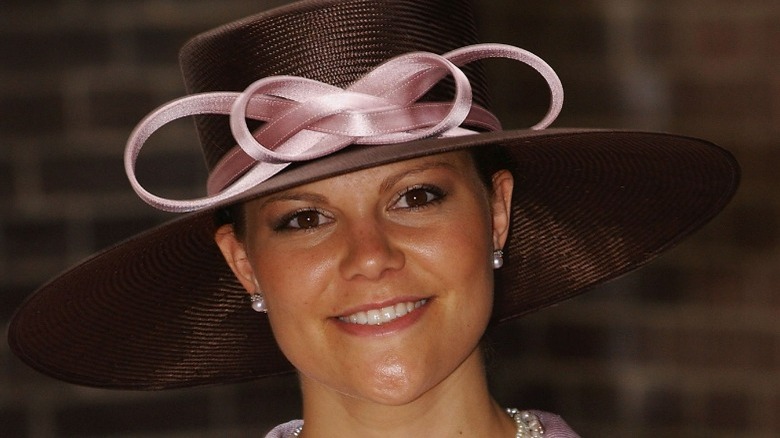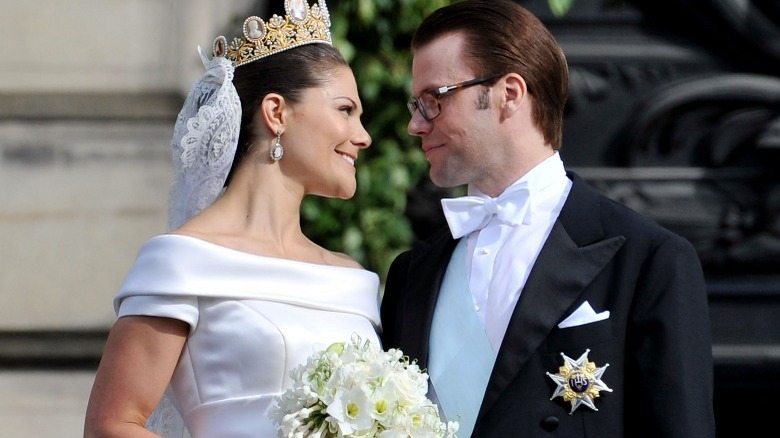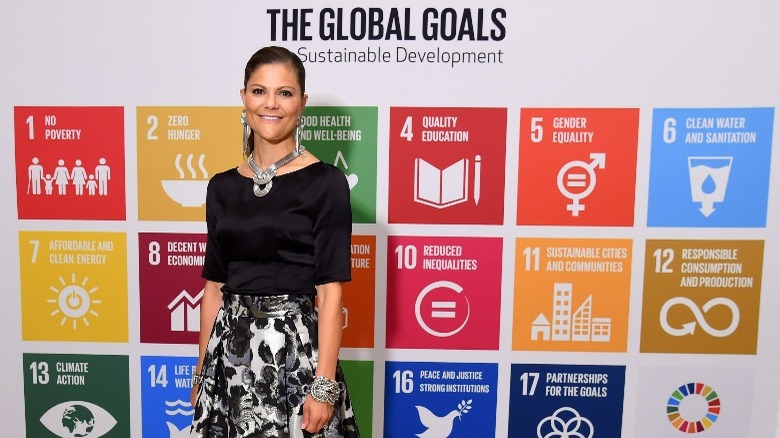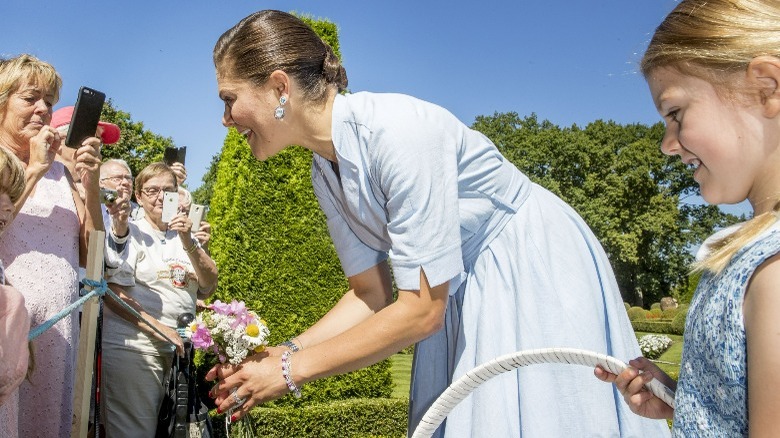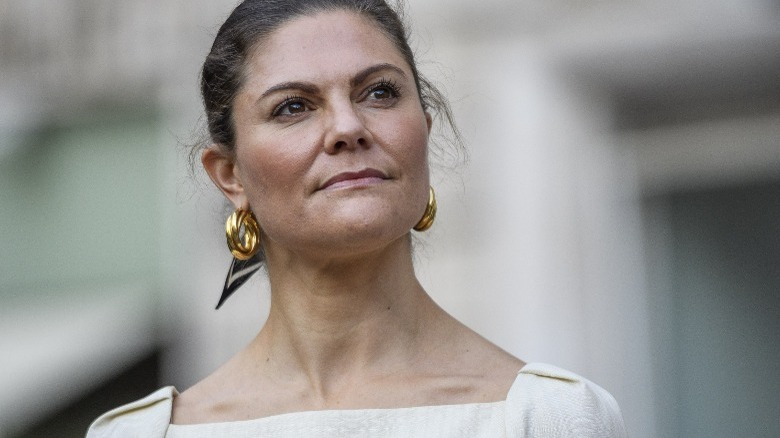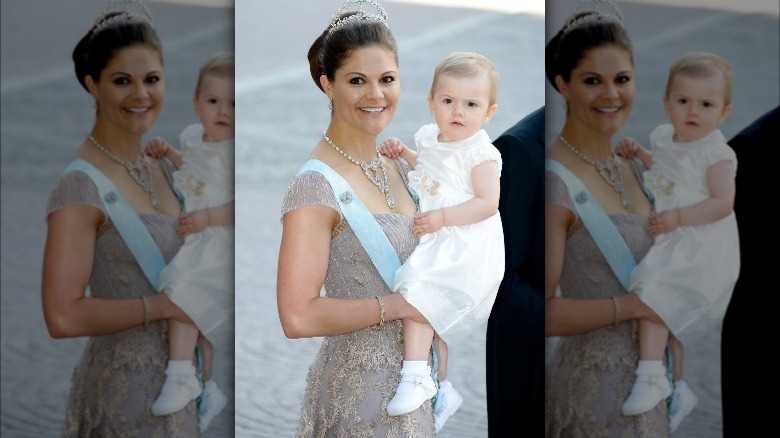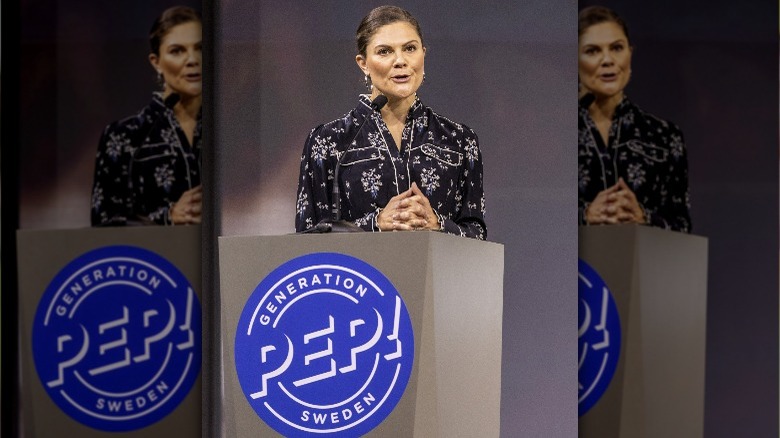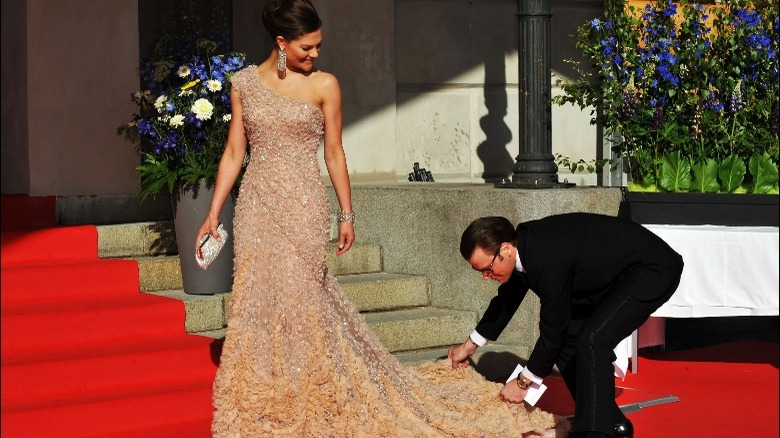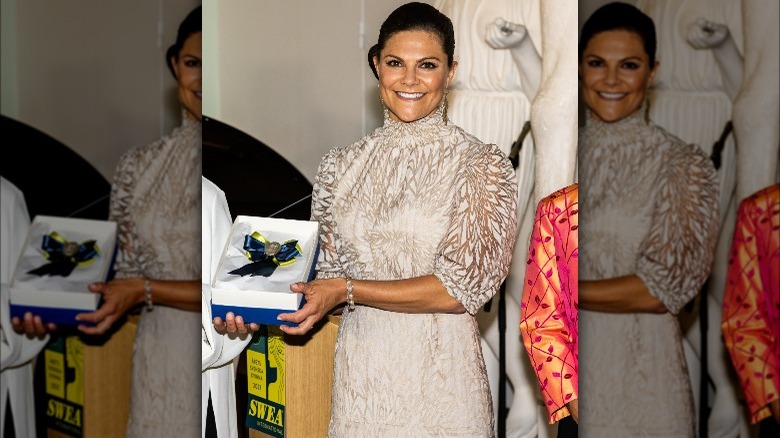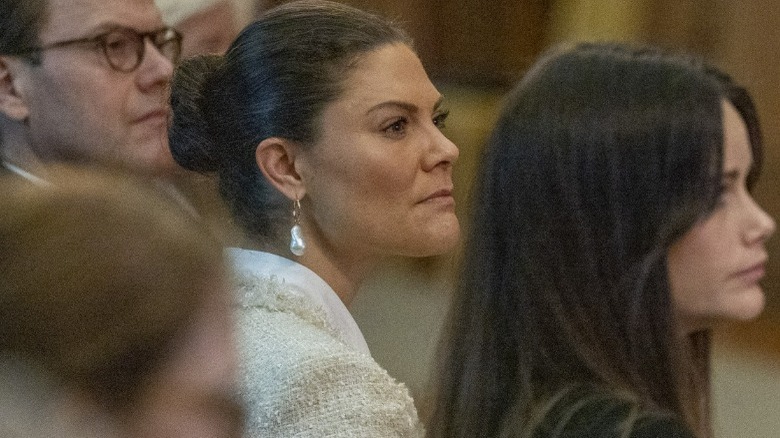The Stunning Transformation Of Sweden's Crown Princess Victoria
Correction 10/17/22: An earlier version of this article misstated Prince Daniel's position as the future king of Sweden. This reference has been removed.
The word princess often brings to mind something of a mix between a Disney fairytale and the British royal family: a woman adored by her constituents, dressed in dazzling bespoke gowns complemented by audaciously jeweled tiaras and necklaces. We think of lavish castles, jet-setting itineraries, and a glamorous lifestyle so opulent that even celebrities gawk in envy.
This is, of course, a fallacy. Princesses are human. And though their lives seemingly appear pristine on the outside, many of them feel the pressure of following centuries-old traditions and facing constant public scrutiny. As Princess Diana once famously said, "Being a princess isn't all it's cracked up to be" (via Live Science).
And so it is with Crown Princess Victoria, the next in line to the Swedish throne. Born Victoria Ingrid Alice Désirée, the future queen of Sweden has had to overcome incredible obstacles to become the picture of poised regal elegance we see today. Much like Diana, she believes in leading with empathy and compassion and breaking with royal conventions when her heart compels her to. Now, she is recognized as one of the most benevolent, forward-thinking, and popular public figures in Sweden. But her unorthodox journey from childhood to today is what really distinguishes her from her contemporaries. Here is the stunning transformation of Sweden's Crown Princess Victoria.
Crown Princess Victoria was born to be a queen
In 1979, the Swedish Parliament made a historic decision to amend the country's Act of Succession and adopt equal primogeniture, meaning that the sovereign's eldest child, regardless of gender, would inherit the throne (per Britannica). Sweden was the first country in the world to enact such a law, and it had a great impact on its monarchy.
When the constitutional reform took effect on January 1, 1980, Princess Victoria was two years old. Since parliament made the law retroactive, Victoria, the firstborn child of King Carl XVI Gustaf and Queen Silvia, became formally known as Crown Princess Victoria, the heir apparent to the throne. This also meant that her brother, Prince Carl Philip, fell behind her and whatever children she would have in the pecking order. According to Woman & Home, Victoria will be Sweden's fourth female monarch and the first since 1720.
Though such titles as king and queen have a ring of nobility and gravitas, in Sweden, the monarch acts as a head of state — a national symbol of pride and unity as opposed to an absolute ruler or a political decision-maker, notes The Art of Living. Still, Swedish royals hold a significant responsibility to represent their country on the world stage. This was made all the more apparent when young Victoria began preparing for her role as future queen from an early age.
She was bullied as a child because she has dyslexia
As a young girl, Crown Princess Victoria realized there was something amiss with her ability to read, speak, and write (per Royal Central). She had dyslexia. People with dyslexia have greater challenges reading, writing, spelling, and speaking because it is difficult for them to connect the letters they see to the sounds those letters make, states WebMD.
Sadly, like many children with learning disabilities, Victoria endured her share of bullying at school. Astute and ambitious, she worked with tutors to help manage the learning disorder — but she still struggled (per Royal Central). A 2002 BBC News article reported that Victoria spoke at a conference on bullying at the University of Orebro in Sweden. Kids, she explained, would make fun of her as she read aloud and stumbled over her words. "I used to think I was stupid and slow," the princess said at the conference, adding, "For me school was fun, but it was also very demanding. When one has reading and writing difficulties, it can be tough sometimes." She also said that she has no problems talking about her learning disability openly, but she also realizes that she, as a future queen, has received more support than most.
She has a congenital disease that causes face blindness
Adding to the challenges she's had to overcome with dyslexia, Crown Princess Victoria has another developmental disorder she's had to learn to manage: prosopagnosia, or facial blindness, which is the inability to recognize faces. This includes familiar faces or, in some cases, even one's own. According to Time, the neurological disorder is incredibly rare: Roughly 2% of the population has congenital prosopagnosia.
What do faces look like to someone who has facial blindness? As Romina Palermo, associate professor of psychology at the University of Western Australia, explained to ABC News Australia, people with prosopagnosia recognize the "individual parts that make up the face" rather than the whole face. She added, "We know that people who see faces more as wholes tend to be better at recognizing faces."
It's hard to imagine a princess — one who mingles and interacts with others regularly — not being able to recognize faces. In 2008, Victoria revealed to the public that she was diagnosed with prosopagnosia. Speaking of her condition to the Swedish magazine Foraldrakraft, she said, "I find it very hard to remember names and faces, and that is a big drawback in my capacity because obviously I meet an awful lot of people" (via CNN).
The crown princess developed anorexia as a teen
After graduating secondary school in 1996, Crown Princess Victoria studied French at the Université Catholique de l'Ouest in Angers, France, according to Britannica, with plans to study at Sweden's Uppsala University the following year (per Hello!). However, when the media released pictures of her looking thin and frail, the public scrutiny intensified. This led the Royal Court to reveal that Victoria had an eating disorder. In 1998, she moved to the U.S. to study at Yale University while undergoing treatment (per The Sunday Times).
Evidently, the pressure of becoming a queen, the constant scrutiny, and the lack of privacy became too much for her. In 2002, Victoria opened up for the first time to the press, sharing the disconnect she felt from her inner self to the one she presented to the world: "I, Victoria, didn't exist. It felt like everything in my life and around me was controlled by others. The one thing I could control was the food I put in me" (via The Art of Living). As noted by Hello!, although Victoria has said she enjoys being a princess, she admits "there are times when you wish you were somewhere else, and someone else."
If you are struggling with an eating disorder, or know someone who is, help is available. Visit the National Eating Disorders Association website or contact NEDA's Live Helpline at 1-800-931-2237. You can also receive 24/7 Crisis Support via text (send NEDA to 741-741).
Her diverse educational background prepared her to be a queen
Since high school, Crown Princess Victoria embarked on educational pursuits that would prepare her for her future role as queen. After studying political science and history at Yale University from 1998 to 2000, she continued her extensive training as an intern at the United Nations in New York City and at her country's embassy in Washington, D.C. (via Britannica).
Victoria then worked at the European Union and the Swedish Trade Council, as well as at other Swedish government offices throughout Europe. In 2003, according to the Irish Examiner, she began a three-week military basic training program at the Swedish Armed Forces International Center. Asked by a reporter what she thought of the training, the future queen, in full camo face paint and army fatigues, responded that the training was "tough" but "extremely interesting" and that she "learned a lot" (via Biography TV).
A few years later, Victoria enrolled at the Swedish International Development Cooperation Agency to learn about Sweden's diplomatic and foreign policies and then continued her studies on international peacekeeping at Uppsala University (per Hello!). During breaks from her coursework and internships, she traveled extensively, representing Sweden across the globe. In addition to her native language, she also speaks fluent English, French, and German (per Royal Central).
Crown Princess Victoria broke royal tradition and married her personal trainer
A familiar trope emerges in romantic movies: A serendipitous encounter results in an unexpected love, one typically between two people who, if not for fate, would have never crossed paths. Occasionally, however, fairytale love stories happen in real life.
When Princess Victoria moved back home after studying in the U.S., a friend advised her that exercise could help with the anxiety that triggered her symptoms of anorexia (per Hello!). Victoria joined an upscale gym, Master Training, where she met the owner, Daniel Westling, who also served as her personal trainer, reported Vanity Fair. The two developed a deep friendship as Victoria recovered from her eating disorder. Afraid of her parents' reaction, she kept their relationship secret, knowing Daniel wouldn't be readily accepted since he was not a royal (per Vanity Fair).
Eventually, she came clean, and, although her parents disapproved of the relationship at first, they eventually embraced Daniel. The couple announced their engagement on June 19, 2010, after their eight-year courtship, reported The Sunday Times. On the big day, over 500,000 people piled onto Stockholm's streets to watch the royal event (per Royal Central). Before the wedding, the groom told CNN, "The queen's main task is to support the king, and in my case, it is to support the crown princess, in their very important work. If I can do it in the same way the queen does, I would be more than satisfied."
She became an advocate to promote the Sustainable Development Goals
In 2016, the United Nations appointed Crown Princess Victoria as one of 17 advocates to promote its Sustainable Development Goals, focusing specifically on water (goals 6 and 14). The goal of an advocate is to promote the U.N.'s climate agenda for 2030 and to build stronger working relationships between the private and public sectors to mitigate the effects of global warming. In a compelling speech at the Stockholm International Water Institute's World Water Week in 2016, Victoria explained the scope of the planet's water crisis: "650 million people lack access to safe water, 2.3 billion people lack access to improved sanitation, and as many as 900 children die every day of diarrheal diseases. This is what we are really talking about when we discuss water."
Since her designation as a U.N. ambassador, the Swedish princess has carried out her role with unflagging determination, speaking at numerous climate events and traveling the globe to meet with foreign leaders to discuss solutions for better water health. In 2017, at a United Nations summit in New York, Victoria spoke with clarity and urgency about taking care of our oceans: "A healthy ocean is not a luxury item," she explained. "It is a necessity for survival. And taking care of the ocean means taking care of ourselves" (per Express Digest).
The crown princess teaches her children the importance of giving back
Crown Princess Victoria and Prince Daniel welcomed Princess Estelle in 2012 and Prince Oscar in 2016, making the young princess and prince future monarchs, behind her mother. Naturally, Victoria would want to prepare her children for their royal duties, including enlisting them in charity work. Per Hello!, Victoria explained in an interview with the Swedish magazine Svenskdam that she openly discusses her philanthropic endeavors with her children — much like her parents did with her. "I think my parents made it very good and educational," she said, adding, "In this way, it becomes, of course, a natural attitude to what the role of such means but also what you are able to assist with."
The royal parents also bring Estelle and Oscar to charity events with them. In March 2022, for World Water Day, Victoria had her two children in tow as she met with WaterAid to discuss solutions for increasing access to clean water, sanitation, and hygiene in developing countries (per Royal Central). To demonstrate what some people in poor communities have to go through to get clean water, she and her children lugged around heavy jugs filled with water, the site noted. Now that's what Take Your Kids to Work Day is all about!
Before her 40th birthday, she spoke publicly about her struggles with mental health
It seems that if there's one hard-and-fast rule for how royals should behave in public, it's this: Don't show emotion. But famous aristocrats like Prince Harry, Meghan Markle, and Crown Princess Victoria, all of whom have spoken openly about the pressures of being in the spotlight, are breaking down those barriers. In a 2017 interview with Sweden's SVT, just before her 40th birthday, the future Swedish monarch spoke candidly about her ongoing struggles with mental health. "The performance anxiety I had is still there," she said, adding, "I've been given different kinds of tools and learned how to manage it" (via The Telegraph).
Though it would have been easy to ascribe her emotional turmoil to being a public figure, having her every move dissected and scrutinized, Victoria dismissed the notion, saying in the interview, "There are as many reasons to feel bad as there are people" (via Hello!). She did, however, express concerns about the unhealthy expectations social media imposes on young people.
With depression and feelings of loneliness on the rise among young people, modern royals like Victoria are setting a positive example about speaking out and destigmatizing mental health challenges.
If you or someone you know is struggling with mental health, please contact the Crisis Text Line by texting HOME to 741741, call the National Alliance on Mental Illness helpline at 1-800-950-NAMI (6264), or visit the National Institute of Mental Health website.
Crown Princess Victoria became known as the 'Godmother of Europe'
In 2017, Crown Princess Victoria earned another impressive title: Godmother of Europe. As of this writing, she has 18 (yes, 18!) godchildren (per Hello!). As the affectionate moniker denotes, she has a godchild in nearly every European country with a monarchy. Three of her godchildren are expected to become kings and queens one day. Some of her royal godchildren include Prince Constantine Alexios of Greece, Princess Ingrid Alexandra of Norway, Prince Christian of Denmark, Princess Catharina-Amalia of the Netherlands, and Princess Eléonore of Belgium (per Royal Central). And, not surprisingly, she is the godmother to her nieces and nephews.
Known for her kindness, generosity, and compassion, Victoria is a beloved royal figure in Europe. She is frequently voted as Sweden's most popular member of the royal family and, by some accounts, could even be described as one of the most popular royal figures in Europe (per the South China Morning Post).
She devotes herself to charity work
Aside from her work as a U.N. alumni ambassador, Crown Princess Victoria is involved with many charities. Some of her interests include education, international peacekeeping, and social justice, particularly creating equitable opportunities for young people. As a devoted patron of the Gundua Foundation, Victoria, who has been with the organization since its founding, champions educational development throughout Kenya. She also helped with the initiative to build primary and secondary schools in impoverished Kenyan communities where they previously didn't exist.
Another of Victoria's passions is getting young people involved in physical activity. To commemorate their wedding day, she and Prince Daniel launched The Swedish Crown Princess Couple's Foundation, which aims "to promote good health and combat exclusion among children and young people in Sweden," notes the foundation's website. One project the couple developed is Generation Pep, a nonprofit that provides coaching for young people on proper nutrition and physical fitness.
One of the many negative consequences the pandemic has had on children worldwide is that it's made them even more sedentary. Some of this, evidently, has been necessitated by remote learning. But Victoria hopes that Generation Pep will be the jumpstart Sweden's kids need. In November 2021, she and her husband helped organize Pep Forum, where over 800 experts and businesses participated, either virtually or in-person, to find solutions to combat the harmful effects COVID-19 has had on young people's physical health (per Royal Central).
The crown princess has evolved into a style icon
Step aside Kate Middleton and Meghan Markle. Crown Princess Victoria is making a place for herself in the style icon canon. From wowing us with her Elie Saab and Oscar de la Renta gowns to making us smile with her casual, sporty looks, this Nordic princess proves she can transition seamlessly between elegant fairytale princess and fashionable girl next door. Like many royal celebrities, Victoria has her go-to designers for special occasions. One of her most memorable looks came from Lebanese designer Elie Saab: a stunning blush-hued, off-the-shoulder gown she wore to the government gala performance the night before her wedding. And it's impossible not to marvel at her ivory satin wedding dress by Swedish designer Pär Engsheden, paired with her mother's jeweled crown and five-meter-long wedding dress train.
What makes Victoria's style even more awe-inspiring is that she supports sustainable fashion. She's not afraid to step out in the same dresses her mother once wore in public —though a hand-me-down from a queen isn't quite the same as our receiving an old sweater from a relative — and she's even making waves in the fashion world. In August 2021, she joined Sustainability Fashion Hub talks, as part of Stockholm's fashion week, where she met with six female founders of different fashion brands to discuss innovative business models that "prolong the lifespan of fashion products and equally reduce waste," states the Stockholm Fashion Week website.
She won the Swedish Woman of the Year Award in 2021
Since Crown Princess Victoria was a child, she has worked toward one goal: to be the leader Sweden needs. But beyond her role as monarch, Victoria has also stood as a symbol of resilience, overcoming dyslexia, prosopagnosia, and anorexia. She was also not ashamed to speak about her struggles publicly, in hopes that her story would inspire others. Devoted to a sense of duty, the future queen has traveled the world promoting Swedish culture and values, forging connections with other countries to find solutions to global problems. So it comes as no surprise that the Swedish Women's Educational Association (SWEA), a nonprofit that builds an international network of support for Swedish women, nominated the princess for its 2021 Woman of the Year Award. Her aunt, Princess Christina, who also serves as SWEA International's honorary president, presented her with the award (per Royal Central).
Barbro Osher, one of the SWEA members who nominated Victoria, said in a statement: "The Crown Princess stands for everything that SWEA identifies with, a contemporary, modern Sweden with openness, inclusion, environmental thinking and care. Features that we Sweor bring with us into the world in a global cross-border sisterhood, where we now welcome our Crown Princess" (via Hola!). The honor came exactly 20 years since Victoria's mother won the award, the site noted.
Crown Princess Victoria has joined efforts to help Ukraine
The Swedish royal family has thrown its full support behind the people of Ukraine following Russia's invasion in February 2022. Not wasting any time, the Swedish monarchy organized a day of events, which took place March 10, 2022, to honor those who have lost their lives during the invasion and to devise strategies to help Ukrainian refugees. The day began with a peace prayer in the Castle Church at the Royal Palace in Stockholm, reported Royal Central. The royal family listened to a sermon and lit candles in remembrance of fallen Ukrainian soldiers and civilians, the outlet noted. Afterward, they joined The Red Cross, UNICEF, UNHCR, and Save the Children in a fundraiser for Ukraine (per Hola!).
Crown Princess Victoria and her family have long supported initiatives that champion the well-being of children. One of the greatest atrocities of war is human trafficking, particularly with children. In late March 2022, the Swedish royal family met with 22 organizations from other countries to discuss how to strengthen the "security and protection" of Ukrainian's children. Queen Silvia, Victoria's mother, noted at the meeting that "almost every second, a child in Ukraine becomes a refugee," per Royal Central. Her Majesty said she hoped the meeting would spark new and productive collaborations — "all to be able to protect children even better."
Though the work of a queen can seem interminable and overwhelming, one thing is clear: Crown Princess Victoria is up for the task.
